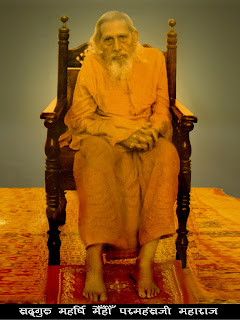The word 'Kuppa' means a tunnel or cave, and "Ghat" means place located on a river-bank. Accordingly, there is a cave at Kuppaghat which has been rendered famous and immortalized by Maharshi Mehi Paramhans, the legendary exponent of Santmat. Maharshi Mehi practiced surat shabd yoga or the Yoga of Inner Sound for several months here in this cave and later constructed his Ashram also; several yogis or spiritual aspirants can still be seen practicing the Yoga of Inner Light & Sound in this dark cave completely insulated from the din & bustle and brightness of the outside world. Maharshi Mehi Ashram blossomed under his dynamic leadership to become the national headquarters of Akhil Bharatiya Santmat-Satsang. It has an aesthetically laid out garden and orchard beautifully punctuated with sculptures, paintings and quotes having spiritual significance like a cottage showing Lord Ram visiting great female devotee Shabri and killing of Jatayu, the vulture, at the hands of the demon king Ravana.
Click here to Watch Video
Maharshi Mehi Paramhans is revered as a great sant in the illustrious tradition of Sant Mat. He made an in-depth study of Vedas, main Upanishads, the Bhagavad Gita, the Bible, different sutras of Buddhism, the Quran, saintly literature and from this assessed that the essential teaching contained in all of these is one and the same. Mehi was a direct disciple of Baba Devi Sahab of Muradabad, Uttar Pradesh, India who had special blessings of Sant Tulsi Sahab of Hathras, Uttar Pradesh, India
Click here to Watch Video
Maharshi Mehi Paramhans is revered as a great sant in the illustrious tradition of Sant Mat. He made an in-depth study of Vedas, main Upanishads, the Bhagavad Gita, the Bible, different sutras of Buddhism, the Quran, saintly literature and from this assessed that the essential teaching contained in all of these is one and the same. Mehi was a direct disciple of Baba Devi Sahab of Muradabad, Uttar Pradesh, India who had special blessings of Sant Tulsi Sahab of Hathras, Uttar Pradesh, India
Maharshi Mehi was born on 28 April 1885 in a small village of Bihar, Majhua (Khoskhsi Sharanpur), India. From very early age he was a seeker of truth and had an intense thirst for inquiry. His search finally to the feet of his teacher, Baba Devi Sahab, in 1909. As directed by his teacher, Mehi spent many years in intense meditation and eventually located at Kuppaghat on the banks of the Ganges near Bhagalpur in the state of Bihar.
Maharshi Mehi was born on the fourteenth day of the Shukla Paksha ofVaisakha (28 April 1885) at his maternal grandparents’ home in Khokhsi Shyam Village, in Saharsa, Bihar, India. His father, Babujan Lal Das, a deeply religious man, was a resident of the village named Sikligarh Dharahra, a place that was soon to become immortal and sacred in the hearts of millions of devotees of Mehi and which now houses an Ashram which is regarded as amongst the holiest of places associated with Sant Mat. Sikligarh Dharahra comes under Banmankhi police Station in the District of Purnea in the state of Bihar, India.
Mahrshi Mehi Paramhansji Maharaj (1885–1986) :- Among saints Maharshi Mehi Paramhansji Maharaj is the main figure in modern era. He was born at village- Khokhshi Shyam (Majhua) Dist. - Madhepura, Bihar (India) in 1885 a day before Baishakhi Purnima. His paternal village is Sikaligarh Dharhara (Banmankhi) Dist. - Purnea, Bihar (India). He was religious from his childhood. Once he was answering a question from the poem ‘Builders’ in matriculation examination 1904. By unborn power he left the examination-hall and set out in search of suprime goal of life i.e. ‘God Ram’. After a long search he met a great spiritual preceptor ‘Baba Devi Sahab’. Under the direction of this teacher he understood Santmat exactly. He had a self divine realisation in meditation for 18 months in the cave of Kuppaghat, Bhagalpur (Bihar). He worte down his base book of Santmat - ‘Satsang-yoga’. Many other books were also composed by him in Hindi that gives a solid base to Santmat. He spread Santmat extensively moving on troublesome vehicles even in old age. Among regular meditation and satsang he left this earth on 8 June 1986 completing the age of 101 years.
twitter
https://twitter.com/ramanmgr
https://twitter.com/ramanmgr


